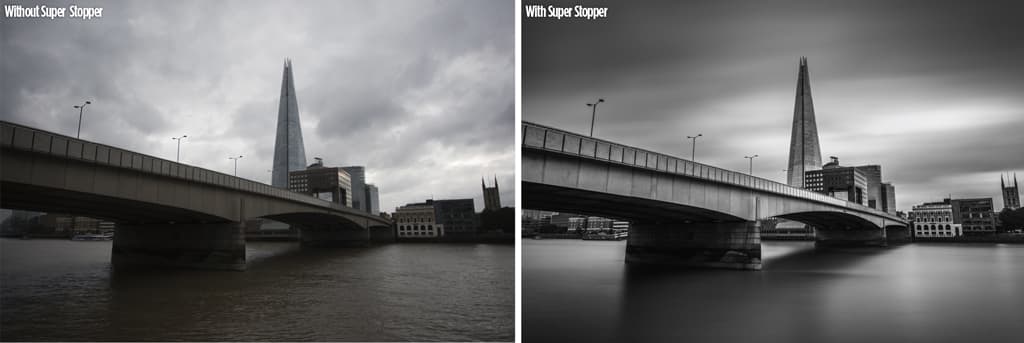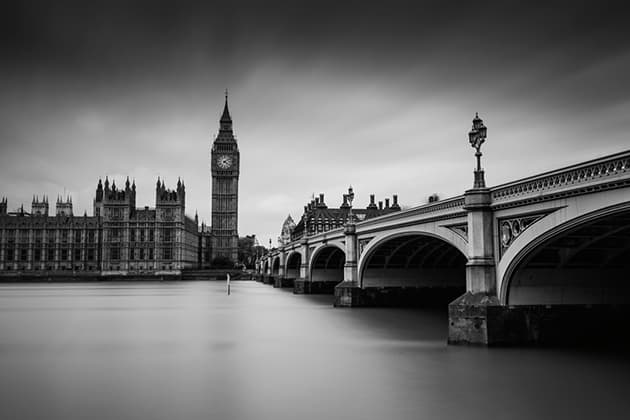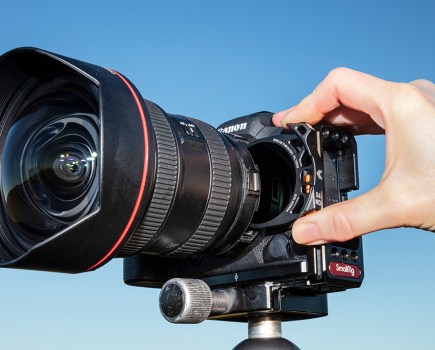
Without Super Stopper: Canon EOS 5D Mark III, 17-40mm, 1/125sec at f/6.3, ISO 100. With Super Stopper: Canon EOS 5D Mark III, 17-40mm, 4mins at f/6.3, ISO 100
Lee Filters Super Stopper at a glance:
- Filter holder Designed to fit Seven5, 100mm and SW150 sizes
- Material Lee Filters glass
- Filter factor 32,000
- Protection Supplied in protective case made of tin
First there was the Big Stopper, then there was the Little Stopper and now there’s the Super Stopper. Over the past six years we’ve seen Lee Filters gradually establish its line-up of long-exposure neutral-density (ND) filters to the point where there are now three different strengths to choose from. Although the purpose of all three filters in the range is exactly the same – to cut down the amount of light that passes through the lens to the sensor, allowing us to increase the exposure time and get creative with the blurring of moving subjects – it’s important to understand that they’re all intended for slightly different situations.
During sunrise and sunset, when light levels can be fairly low, a neutral-density filter such as the Lee Filters Big Stopper, which cuts out 10 stops of light, can provide us with an exposure that in effect is too long. Say you’re shooting a late evening landscape and your camera is giving you a meter reading of one second at f/8 and ISO 100. With the Lee Filters Big Stopper attached, you’d need to keep the shutter open for a lengthy 16 minutes to achieve the correct exposure. Before you know it, the opportunity of a great shot might disappear and you’re left with only a couple of images to show for your efforts.
To retain detail and texture in areas such as sky and water, while still conveying a sense of time passing, many photographers will opt to use an ND filter that’s not as strong during the hours of sunrise and sunset. One such example is the Lee Filters Little Stopper. By using this 6-stop ND filter, as opposed to the 10-stop Big Stopper, you give yourself the chance to work faster and capture more shots in a shorter timeframe.
Equally, there are times later in the day when the sun can be incredibly harsh when 6-stop and 10-stop ND filters struggle to block out sufficient light to provide us with a shutter speed slow enough to achieve the blurred effect we want. This leads us onto the Lee Filters Super Stopper – the strongest ND filter in Lee Filters’ Stopper range. It allows us to reduce the amount of light that enters the lens by a phenomenal 15 stops. To find out the extremes to which photographers can now take their long exposures, we put the filter to the test under the glare of midday sun as well as in typical British overcast conditions.
Features
To put the strength of the Lee Filters Super Stopper into perspective, it’s capable of turning an ordinary two-second exposure into one that takes17 hours and 4 minutes to expose. To be slightly more realistic, a 1/500sec shutter speed you might achieve on a bright sunny day turns into a one-minute exposure with the Super Stopper attached. By allowing such little light to penetrate the filter, it will see most use when the manufacturer’s Big Stopper doesn’t provide the lengthy exposures one might hope to achieve in broad daylight.
There’s the argument, of course, that the best light is when the sun is at its lowest in the sky, usually at the crack of dawn during sunrise or late in the day during sunset, so you might well ask the question, is there a real need for this filter? If for whatever reason an early start or late finish isn’t an option, or you’d like to continue shooting after dawn and not have your day curtailed by not being able to use slow enough shutter speeds with the Big Stopper, the Super Stopper is your answer.
Just like the Little Stopper and Big Stopper, the Super Stopper is manufactured from high-quality glass and is protected in a black tin. Lee Filters has always been very good at supplying its filters in pouches and metal tins to prevent the sort of damage that can occur when working in challenging environments, and the Super Stopper is no exception.
Being the slot-in type of filter, you’ll need the appropriate sized adapter ring for your lens before attaching a filter holder. The good news is it’s available in each of the manufacturer’s three filter systems (Seven5, 100mm and SW150), and to ensure there is a light-tight seal between the filter and the filter holder, a rubber gasket is permanently attached, which helps differentiate the back of the filter from the front. As is usually the case with filters, the price varies depending on the size you choose. The smallest (75x90mm) Seven5 Super Stopper costs £70, while the larger (100x100mm) Super Stopper and SW150 (150x150mm) Super Stopper will set you back £103 and £129 respectively. These prices exclude a filter holder, so if you don’t already have one you’ll need to factor in an extra £66 for a Seven5 filter holder, £54 for a 100mm filter holder and £150 for a SW150 filter holder. There’s the cost of adapter rings to consider, too, with Seven5 adapter rings (37.5-72mm) costing around £18 each, 100mm (49- 105mm) costing around £35-£50 and SW150 filter rings (72-105mm) working out at £70-95 each.

Without Super Stopper: Canon EOS 5D Mark III, 17-40mm, 1/640sec at f/5.6, ISO 200. With Super Stopper: Canon EOS 5D Mark III, 17-40mm f/4 L USM, 50secs at f/5.6, ISO 200
In use
Just as with the Big Stopper, there’s a process you have to go through to create successful long exposures. This all starts with locking off the camera on a tripod before connecting a cable release and composing the image. Attempting to focus with the Super Stopper attached will send your camera’s autofocus system into disarray – you simply can’t focus or take an accurate meter reading through it. Instead, you’ll need to focus and then switch to manual focus to lock it before calculating the exposure yourself.
The easiest way to do this is to use the Lee Filters’ app that’s available free to download for iOS and Android. Using it couldn’t be easier – simply select the Super Stopper filter option and scroll a wheel on the left to match your camera’s metered shutter speed. Spinning the wheel to match the 1/125sec exposure I was getting on a gloomy day revealed the new exposure with the Supper Stopper attached would be 4 minutes – long enough to ignore the plethora of city cruise boats and turn the surface of the River Thames smooth.
After setting the DSLR to its bulb mode and double-checking the aperture is the same as previously metered by the camera, the Super Stopper can then be slotted into the filter holder. Built into the app is a handy timer, which, when started at the same time as the exposure, provides a precise countdown of the time remaining. An alarm also sounds at the end to tell you to stop the exposure.
Despite using the Super Stopper in overcast conditions (for which it’s not primarily designed), it performed well, and with the help of the intuitive app I found it quick and easy to calculate new exposures at different locations. A few days later, I was shooting a scene during the peak of the midday sun, where a longer exposure was required to flatten out ripples on a large expanse of water. Using the Big Stopper would turn my 1/640sec exposure into a 1.6-second exposure. However, I wanted to shoot with a longer exposure than this, so out came the Super Stopper. Its flexibility turned my 1/640sec exposure into a 50-second one.
Colour casts are often a concern for photographers who use long-exposure filters, but the Super Stopper performs well in this regard. Using the filter with the camera’s white balance fixed to daylight produced images that were only slightly cooler than those captured without it, and it wasn’t difficult to correct.
Our verdict
The Lee Filters Super Stopper is a strong ND filter, which, unlike the Lee Filters Big Stopper, doesn’t allow you to see anything at all through it when it’s raised to your eye. The fact it’s so strong means that it’s intended to be used at times of the day when the Little Stopper and Big Stopper are ineffective. It will see most frequent use in bright, high-contrast conditions where it’s difficult to create long exposures, and rather than dismissing long-exposure photography at certain times of the day as you may have done in the past, it’s now very much a possibility.
Before purchasing this filter, you’ll want to ask yourself the question, how often do I find myself wanting to shoot long-exposure images in broad daylight? If your answer is quite often, then it’s definitely worth the outlay. If you regularly shoot during the golden hours of sunrise and sunset, you’re less likely to get full value from it. Although there’s no denying that it’s a good filter to have in your collection, it’s not what I’d consider essential or as practical as the Little Stopper or Big Stopper.
The great news is that with three filters in the Lee Filters Stopper line-up, there’s now a greater range of long-exposure filter options to meet all photographers’ needs. If I were a newcomer to the Lee Filters system, the Big Stopper would remain my first choice, with the Little Stopper a close second.

Without Super Stopper: Canon EOS 5D Mark III, 17-40mm, 1/250sec at f/6.3, ISO 125. With Super Stopper: Canon EOS 5D Mark III, 17-40mm, 2mins at f/6.3, ISO 125








